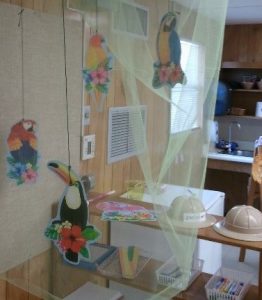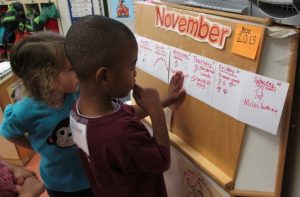Don’t Wait for a Teachable Moment…Create One!
March 2021
Relevant Research
What is a Teachable Moment?
A teachable moment is an unplanned or random event during the day that provides an opportunity for a teacher to connect or link back to:
- Previous information,
- Expand upon a concept,
- Scaffold, or
- Enrich the activity with additional learning.
“A teachable moment provides opportunities to further student learning and includes the time during which learning a particular topic or idea becomes possible or easiest” (Hyan & Marshall, 2003).
Teachable moments are a fleeting opportunity that teachers need to quickly identify and seize, but there are actions that teachers can take that encourage learning opportunities within the class. For example, a teacher who rotates and changes a bucket of materials each week on various learning center shelves, adds and modifies the learning environment to become theme relevant, and places charts at eye level for the children is intentionally designing a classroom where teachable moment opportunities can happen!
Benefits of Using Teachable Moments
One of the benefits of using teachable moments is that it makes a topic or concept easier for the child to understand because they are getting new information in the context of their real world. This can make concepts easier to absorb by the child since they can take the idea and immediately practice the skill.
Another benefit is that it is more likely to be developmentally appropriate with the children. The teacher would be present in the moment, join the event or activity that interests the child, and add to their experience.
Developmentally appropriate practices allow an activity to be:
- Relevant to the children
- Authentic to the curriculum content
- Prompted by the child’s interest
- Adaptable to the diverse needs of the children
Creating a Teachable Moment
According to researchers Eunsook Hyun and J. Dan Marshall, there are three steps that teachers of early childhood students must take in order to take advantage of teachable moments: observe, recognize, and interpret the spontaneously occurring interests of diverse learners.

A teachable moment is often unplanned, but we can set up opportunities during the day for teachers to be intentional. Teachers can set up activities to connect or link back to previous information, expand upon a concept, scaffold learning, and enrich the activities with additional learning by observing and tuning in to children to recognize their cues as opportunities to build upon their learning.
#1 Observe the Children
The first step to take advantage of teachable moments is to observe the children. It is best practice to pay attention and watch children to notice their cues. Teachers can look for children’s interests or signs of eagerness to learn more about something and listen to hear if they are asking questions. Teachers can reflect and ask themselves:
- What do I see happening?
- What do I hear the children saying?
- What are children’s interests?
#2 Recognize Opportunities
The second step is to recognize the opportunities for connecting children and learning together. When teachers are familiar with the children’s interests and familiar with the curriculum and learning objectives, they can plan and connect the content with the child’s activities. We are more likely to provide individual support and practice opportunities for the children when we narrow down the learning objectives.
Teachers can reflect and ask themselves:
- What are some learning objectives that I currently have to work on?
- What is the current theme?
- What vocabulary words connect to the activity?
- Is there a way to connect the children’s interest with the theme?
Teachable moments may take the teacher away from their daily schedule and evolve into a full-blown lesson plan, so teacher flexibility is needed in order to take advantage of these instructional times.

Using Themes
By using a theme, teachers can set the stage with children and provide learning in a shared context together as a group. This can help children make connections, understand what they are learning, and remember what they have learned as active participants. Teachers can enhance their learning by using moments observed during the day to pose questions to the children, expand upon their knowledge and encourage their investigation.
This is an example of using a theme to make it easier to connect concepts together based on children’s interests.

Teacher planning for this theme may include:
- Selecting a variety of children’s books, such as “Going to the Zoo” or “The Baby Beebee Bird” to add to centers
- Adding word cards with the word and picture of a variety of vocabulary words
- Creating an aviary in the Pretend and Learn center and add birds
- Getting a recording of bird sounds from the internet
- Turning the science center into an Insectarium
- Identifying ways to interact with children while they are in centers
- Developing questions to use with the children

#3 Interpret
The third step of taking advantage of teachable moments is to take the time to process what we observed and recognized to understand the child’s point of view and then interpret their behaviors to make a decision on how to respond to their needs.
We want to use intentional teaching strategies to enhance the children’s learning and reinforce their skill development.
Intentional instructional teaching strategies include:
- Modeling for the children to demonstrate an activity or language,
- Creating open-ended questions to encourage their thinking and language,
- Providing explanations and demonstrating our thinking process by sharing it aloud with the children and,
- Being flexible by problem solving as the context and setting changes in the classroom.
A mindful teacher and ready learners can spontaneously share an educational experience. Here a teacher uses large index cards to write down a daily activity during circle time and continued to add them throughout the week to make a mini-calendar for the week. The children are showing interest in revisiting what happened during the day. The teacher can observe the children to see what they are doing and listen to them talking. Then, when there is a question or they may be moving on, the teacher could step in and ask questions about the calendar days, provide an index card for the children to create their own representation of something that happened during the day, or use other ways to build upon their understanding of time.

Using the Classroom Environment
Teachers can use the environment to create teachable moments. Knowing children’s skill development needs you can help scaffold learning and check for understanding while children are engaged in centers. For example, you could visit with Rachel in the Pretend & Learn Center and playfully ask her to produce a word that would rhyme with the story props that she is using, such as parrot, bird, hat, and net. Then move to the Library Center and encourage Tanesha to count the Napping House felt pieces when she cleans up after the story to re-tell the story. Or sit next to Jacob in the Construction Center and model how to use the wooden blocks to create the letter “J”.
Plan Your Work…Work Your Plan
Teachers can set up the classroom-learning environment to spark children’s interest, provide opportunities for children to practice activities that match learning objectives, and create teachable moments. When teachers are mindful and take the time to prepare for activities with the children, then they are more likely to have materials available, such as books that match the theme, consumable items for planned activities, and manipulatives rotated in the different learning centers. Teachers can create an in the moment small group activity by joining a child’s play and asking open-ended questions, scaffolding, modeling language, providing self-talk, and other strategies to build upon what the child knows.
Using the CIRCLE Online Activity Collection
Teachers can engage children by using the CIRCLE Activity Collection that provides activity ideas in English & Spanish for prekindergarten to 2nd teachers and parents to use with children. Some activities have video examples for teachers, scripts based on the Teaching and Learning Cycle, and downloadable files with picture cards to use with the children. This extensive collection of teaching strategies and activities support cognitive, social, and emotional learning. These activities align with the Texas Prekindergarten Guidelines, the Head Start Early Learning Outcomes Framework, and the K-2nd grade TEKS.
Teachers can add interest for the children by adding a variety of different activities from the CIRCLE Activity Collection. Activities to reinforce children’s skills are available to use during center time, while outdoors, in small groups, with transitions, and for the whole group of children. The activities feature scaffolding ideas for teachers to implement with the children based on their needs. Activities may contain a downward scaffold for children needing extra assistance and an upward scaffolding for children who need to be challenged. The activities may also include Teacher Tips to provide consideration for making the lesson more successful with the children.
Reference
Hyun, E., & Marshall, J. D. (2003). Teachable-moment-oriented curriculum practice in early childhood education. Journal of Curriculum Studies, J CURRICULUM STUD(35), page 113.
Teaching Tips
Tips for Creating Teachable Moments
- Intentional planning for an engaging environment provides support for learning in playful activities.
- Observe for times to jump in during activities to help children connect with content.
- Offer a child-centered environment for exploration, skill practice, and language opportunities.
Using Progress Monitoring Data
Using data from observations and assessment results, teachers can create a list of skills that they may want to focus on with the children. Teachers can group children into small groups, large groups, or work individually with the identified children.
Having a system and plan for providing targeted instruction provides the information needed quickly that will allow teachers to provide instruction in the moment, during underutilized contexts, during transitions, or wait times.
When analyzing your assessment data consider the tools that are available to help you develop a plan for children who are identified as in need of intervention:
Using the Small Grouping Tool
We know from research that early identification of learning needs and grouping children according to those needs is known to maximize instructional impact. CLI Engage provides a feature called the Small Grouping Tool that automatically divides children into small groups based on their assessment results. The tool sorts through the assessment results and provides a list of children that have not reached the satisfactory level for each skill. The children placed in these small groups are identified for the teacher as needing more practice with certain skills and would benefit from small group instruction.
Teachers can click on the “View Groups” button located on the Student Assessment screen to see the identified small groups and targeted intervention activities from the CIRCLE Activities Collection. Below is an example of the tool’s automatically selected results.

Links to recommended activities are listed in the Classroom Activities section. The text is hyperlinked directly to the CIRCLE Activity Collection to make it easy to access the lessons that target specific skill areas. Another way to add intentionality with children’s learning is to customize new groups to offer more support for them. As you work with the children, you can add observational notes to any group by clicking on the note bubble button, which will save the notes for future reference.
Recommended Resources








